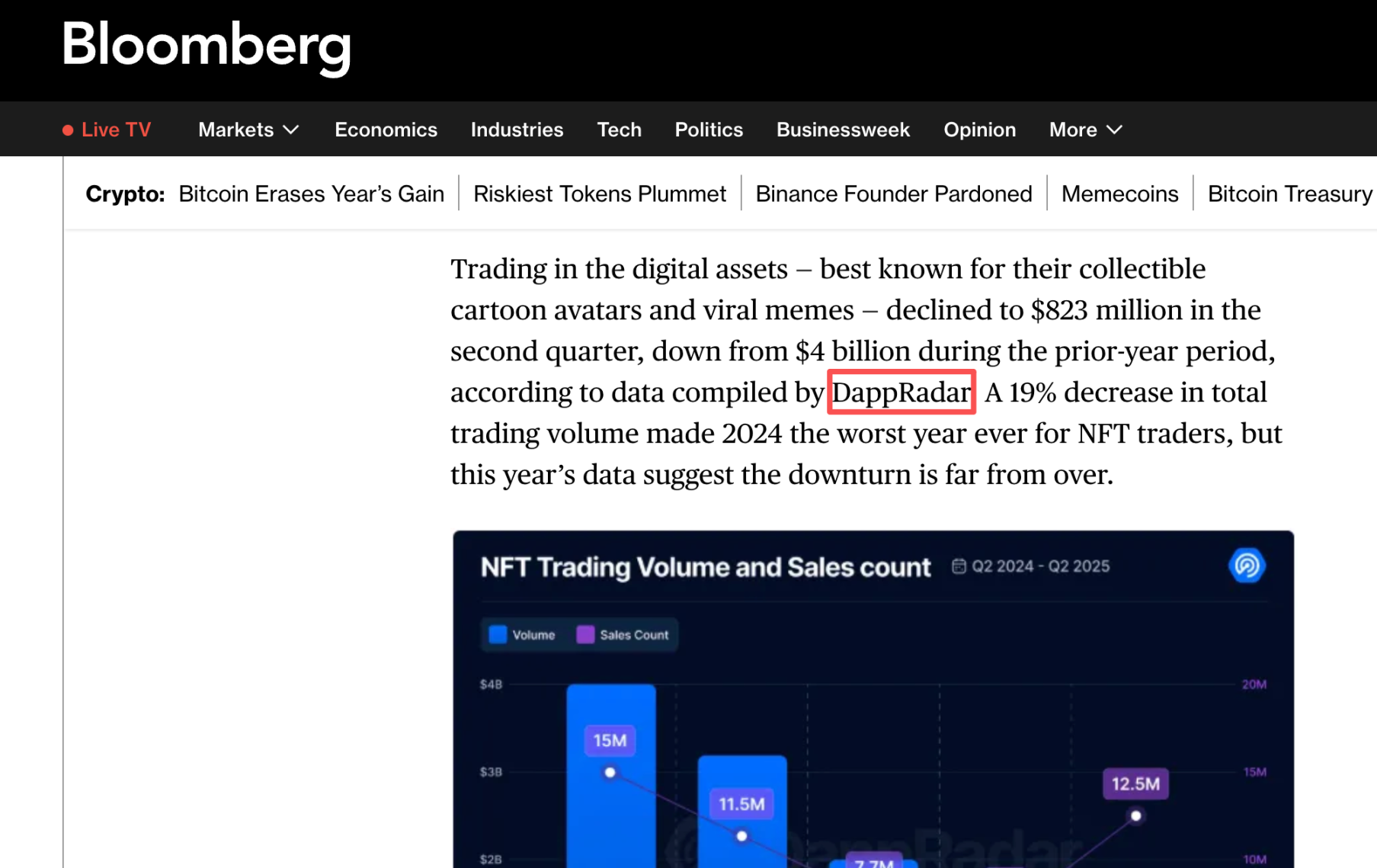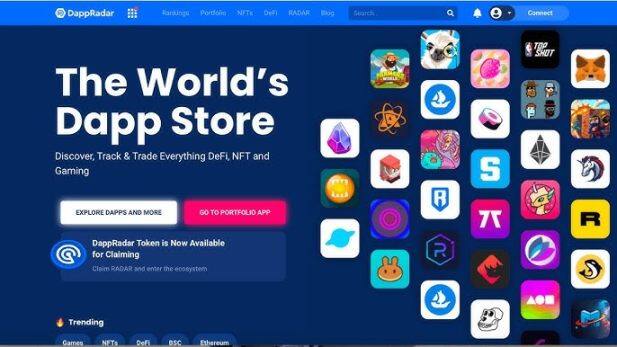DappRadar, yet another tear of the times.
Original author: Eric, ForesightNews
On the evening of November 17, 2025, DappRadar, which had been with the industry for nearly 8 years, announced that it would gradually shut down its services and stop tracking blockchain and DApp data.
It's often said that "a grain of sand in the era can become a mountain on an individual," a saying that perfectly describes DappRadar. Born in what was perhaps the era of the loudest "blockchain is dead" rhetoric, this product accompanied Web3 from its infancy to its nascent stage, yet ultimately couldn't withstand the growing pains of transition. The departure of such a product, so marked by its era, reminds me of what Nokia's CEO said at the end of the Microsoft acquisition announcement 11 years ago:
"We didn't do anything wrong, but for some reason, we lost."
Those were the years we used data websites together
Many newcomers to the Web3 industry may not know that DappRadar was once a very important and authoritative data source. In addition to being cited by CoinDesk and Chinese Web3 media, traditional mainstream media in Europe and the United States, including Bloomberg, Forbes, and the BBC, have also cited DappRadar data many times.

It is considered authoritative because before professional data websites (such as Nansen, Arkham, DefiLlama, etc.) and professional Web3 marketing tools (such as Cyber, Kaito, etc.) became popular, DappRadar was almost the only portal that all DApps had to log in to in its early days. The completeness of the projects made its data completeness and credibility unparalleled, and it became almost the only and best way to quickly understand the basic information of a new project at that time.
DappRadar's co-founder, Skirmantas Januskas, is from Lithuania. Unlike many industry leaders who juggle multiple roles, he has focused solely on DappRadar since February 2018. Prior to that, he only briefly worked in software development at NFQ. Another co-founder, Dunica Dragos, previously worked in operations at the major American game company EA, and similarly dedicated himself entirely to DappRadar after its founding.
DappRadar has received two rounds of funding. In its seed round in September 2019, DappRadar received $2.23 million from Naspers, Blockchain Ventures, and AngelInvest Berlin. Naspers is the South African multinational media group that acquired a 46.5% stake in Tencent from Li Ka-shing, IDG, and others for $32 million in 2001. Then, in May 2021, DappRadar received $4.94 million in its Series A funding round from Blockchain.com Ventures, Prosus Ventures, and NordicNinjaVC.
I found an interview with Skirmantas Januskas after he completed his funding round in 2019. At that time, Web3 was in its darkest hour, but Skirmantas was full of confidence in the industry, believing that as long as the issues of user experience and finding user needs were resolved, "centralized applications will become a thing of the past".

In 2019, this passionate but impulsive entrepreneur shared his insights on DeFi, gaming, and other related sectors, which ultimately experienced explosive growth in 2021. Although DefiLlama captured a large share of the DeFi data market, its comprehensive data and deep understanding of emerging concepts like NFTs, GameFi, and the metaverse allowed it to boast millions of users at its peak. Even small projects whose Twitter accounts couldn't be found could show DAU fluctuating between 0 and 3 on DappRadar.
Specialization became the biggest original sin.
If we had to pinpoint the biggest reason for DappRadar's failure, it would be its overemphasis on cryptography and neglect of the importance of commercialization.
Today, when you browse DappRadar's homepage, you'll find that its categories, besides games, DeFi, NFTs, and gambling—which it has maintained since its inception—and the newly added AI, RWA, and social, lack popular themes like memes. That's why Skirmantas is called a "greenhorn"—it still publishes a detailed report every quarter on NFTs and tracks obscure airdrops, yet it almost completely misses out on all the hot topics.
In the past two years, DappRadar has been arguably the only platform to cover all long-tail sectors and projects in Web3, but the problem is that it seems to only focus on the tail.

This kind of nitpicking expertise might provide Bloomberg and Forbes with excellent material for a report, but it has no commercial value. The RADAR token, launched after its 2021 funding round, seems to have no better use cases besides subscribing to the Pro service, staking, and voting, and it has even blocked the most valuable source of subscription revenue.
The image initially built on comprehensiveness gradually became a constraint. Its DeFi expertise lags behind DefiLlama, its token information seems inferior to CMC, and its research depth doesn't reach the level of Bankless. Its only truly successful area, NFT, has become stagnant. However, DappRadar likely recognized these issues early on and has accelerated its commercialization efforts, including providing high-quality data through its API and offering advertising space.
After its 2021 funding round, DappRadar survived for another four years. While the funding itself undoubtedly generated some revenue through traffic monetization, this revenue was clearly insufficient compared to the costs of providing the exponentially growing volume of data. Furthermore, since 2023, although the market has continued to rise, there haven't been many projects with truly sufficient budgets. Limited budgets have been largely spent on KOLs, exchanges, and emerging platforms, leaving DappRadar, already struggling, increasingly depleted of its resources.
As mentioned before, its coverage is too long-tailed, to the point that project teams may have no way of determining what kind of user profiles would refer to DappRadar information under what circumstances. In its early days, DappRadar provided a channel for understanding new projects, but after the weeding out process, the channels for understanding the few "high-quality projects" have become increasingly widespread, and the old guard is no longer the only or best option.
Compared to the concise website of two or three years ago, DappRadar now appears all-encompassing but disorganized, a result of its overzealous commercialization—a manifestation of the "exhaustive pursuit of every possibility" mentioned in its farewell letter. For DappRadar, without continuous funding or an inexhaustible pool of capital, it needs to demonstrate selectivity in content and restraint in advertising on its website. However, DappRadar's excessive insistence on professionalism, or rather "orthodoxy," and its later realization that this approach was flawed, coupled with its overemphasis on content and ads, has laid bare its operational shortcomings.
Besides its inherent shortcomings, Web3 data and information platforms are inherently a difficult business. The current explosion of multi-chain data has driven up indexing and server costs, creating a market with high demand for high-quality data but a lack of corresponding willingness to pay. Without alternative revenue streams, relying solely on advertising and API sales will inevitably lead to competition. Platforms with low pricing power, in order to survive, increase advertising density while sacrificing user experience, making decline seem inevitable.
DappRadar's seven-year trajectory encapsulates the common commercialization challenges faced by such projects: high value, low fees, rigid costs, and rapid narrative iteration. Its closure offers a stark lesson for those who follow: if the business model cannot be closed-loop from day one, even the most authoritative data cannot prevent it from "bleeding to death."
- 核心观点:DappRadar因商业化失败而关停。
- 关键要素:
- 过度专注长尾数据,缺乏商业价值。
- 代币应用场景有限,订阅收入受阻。
- 数据成本激增,广告收入难覆盖。
- 市场影响:警示数据平台需重视商业模式。
- 时效性标注:长期影响。



